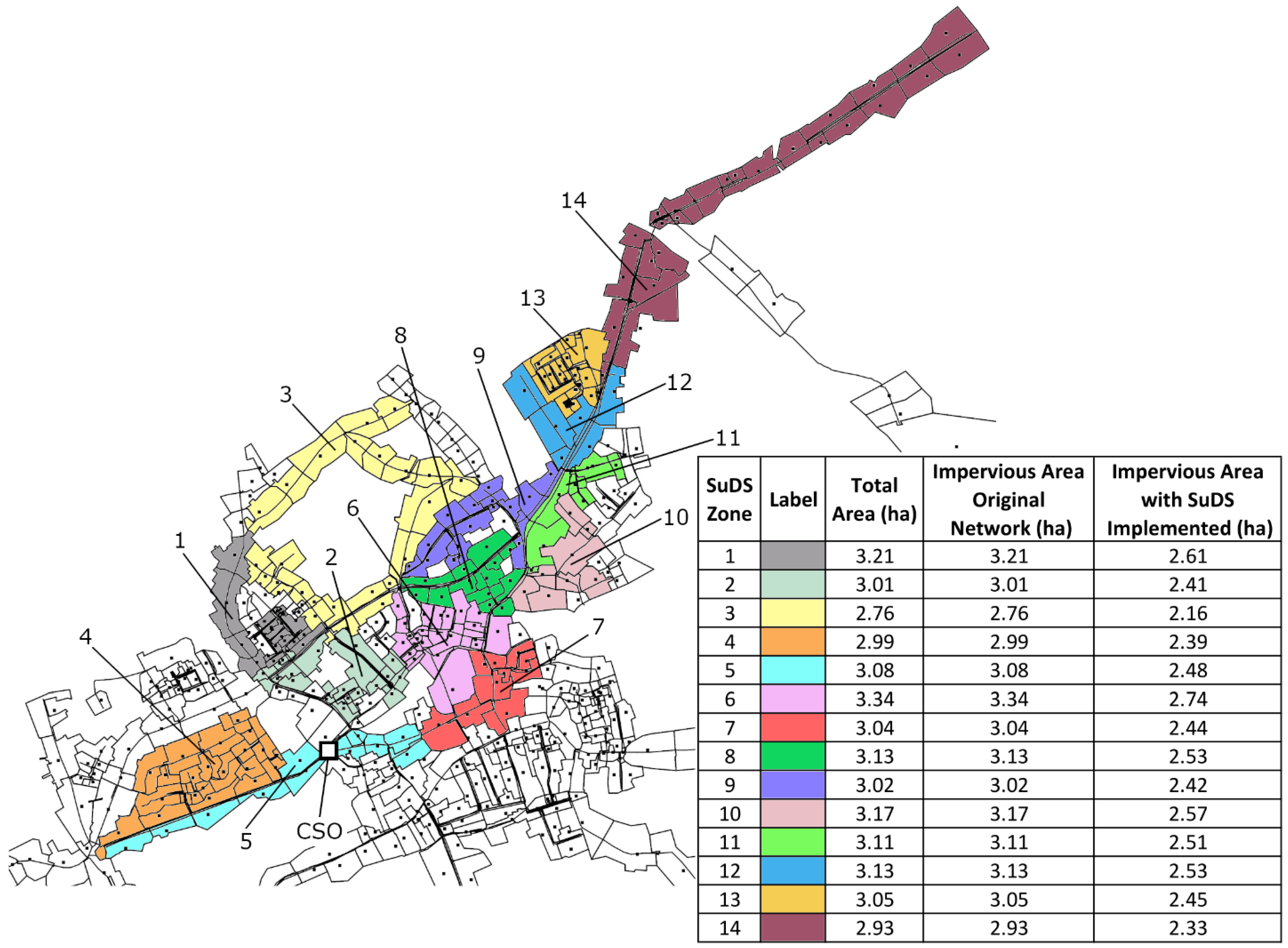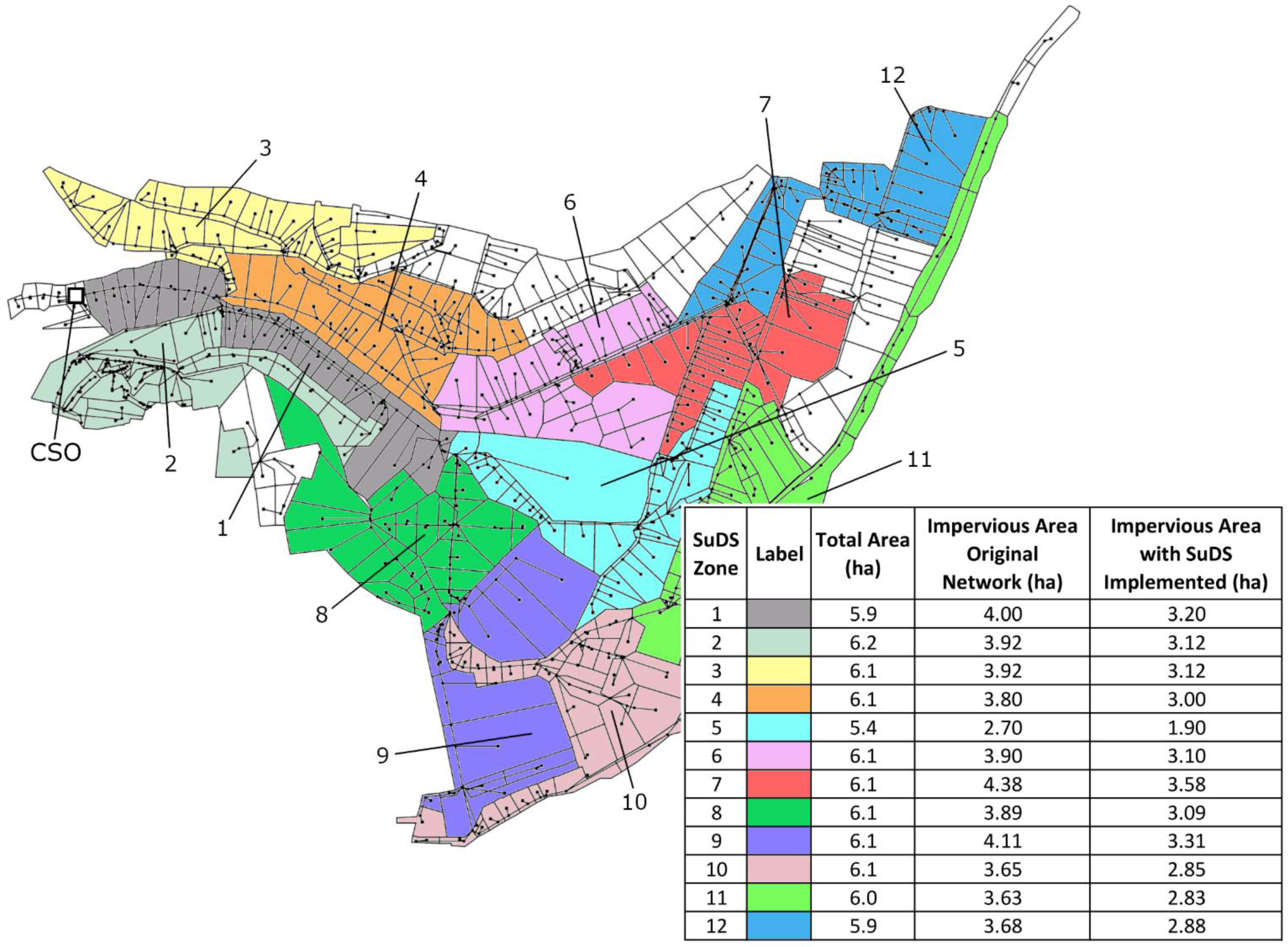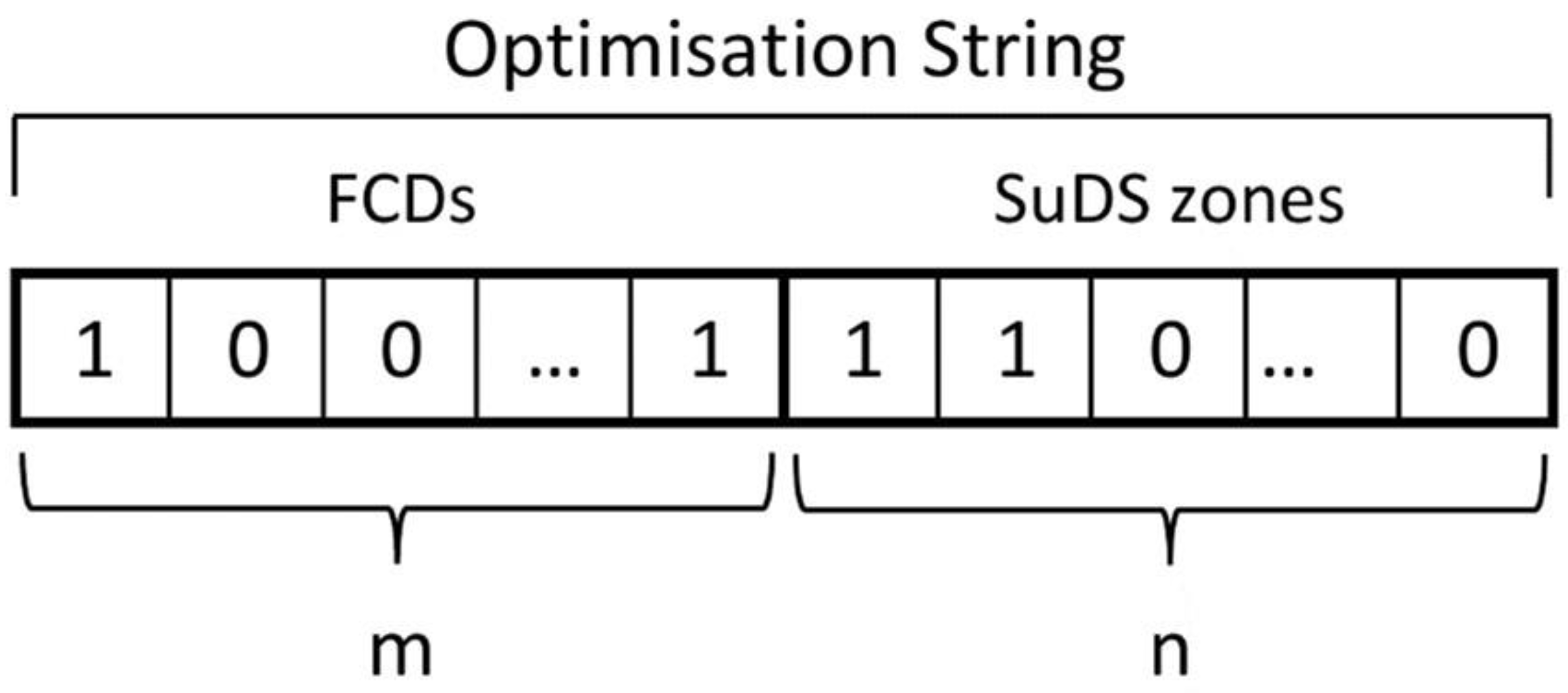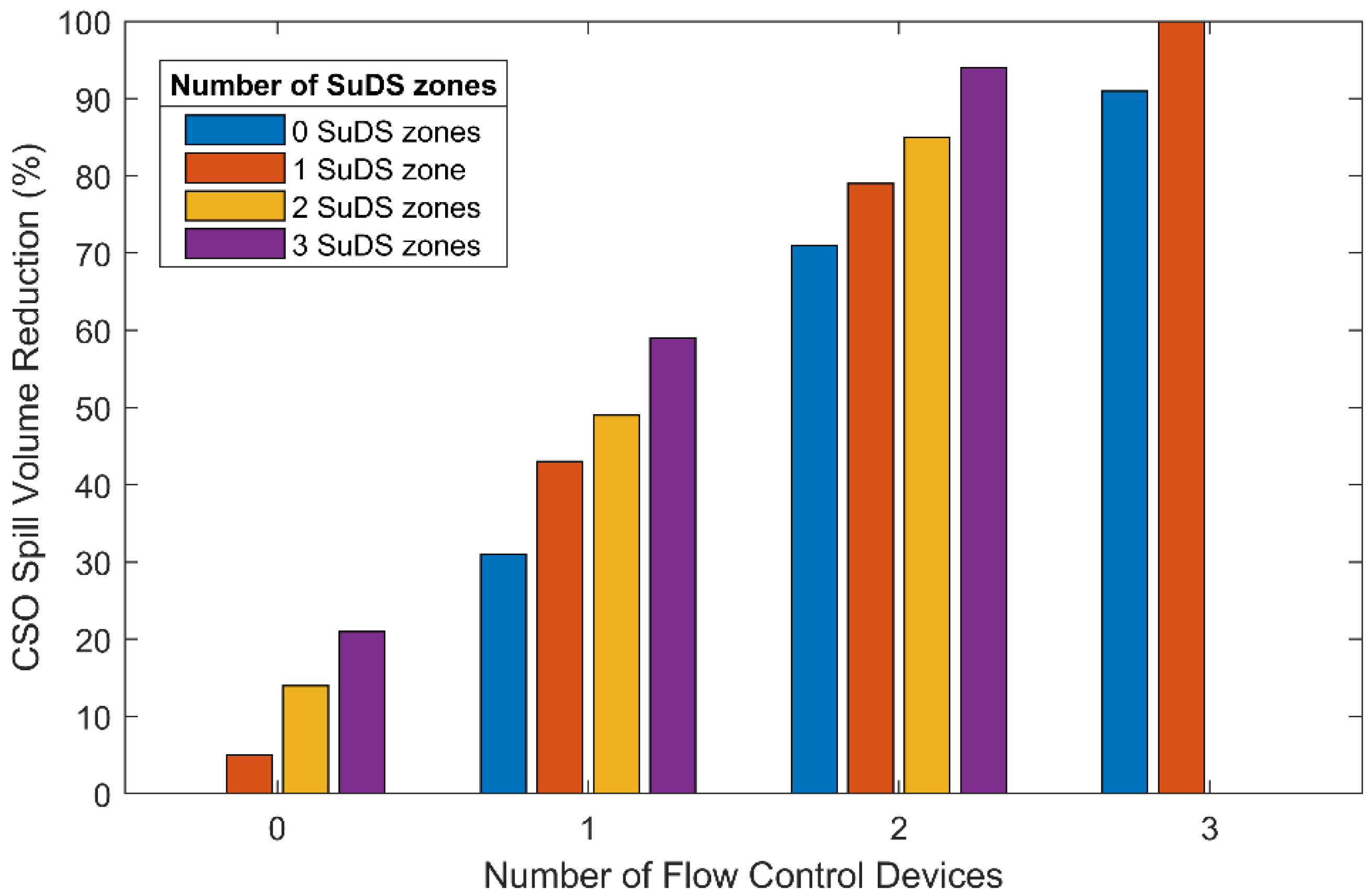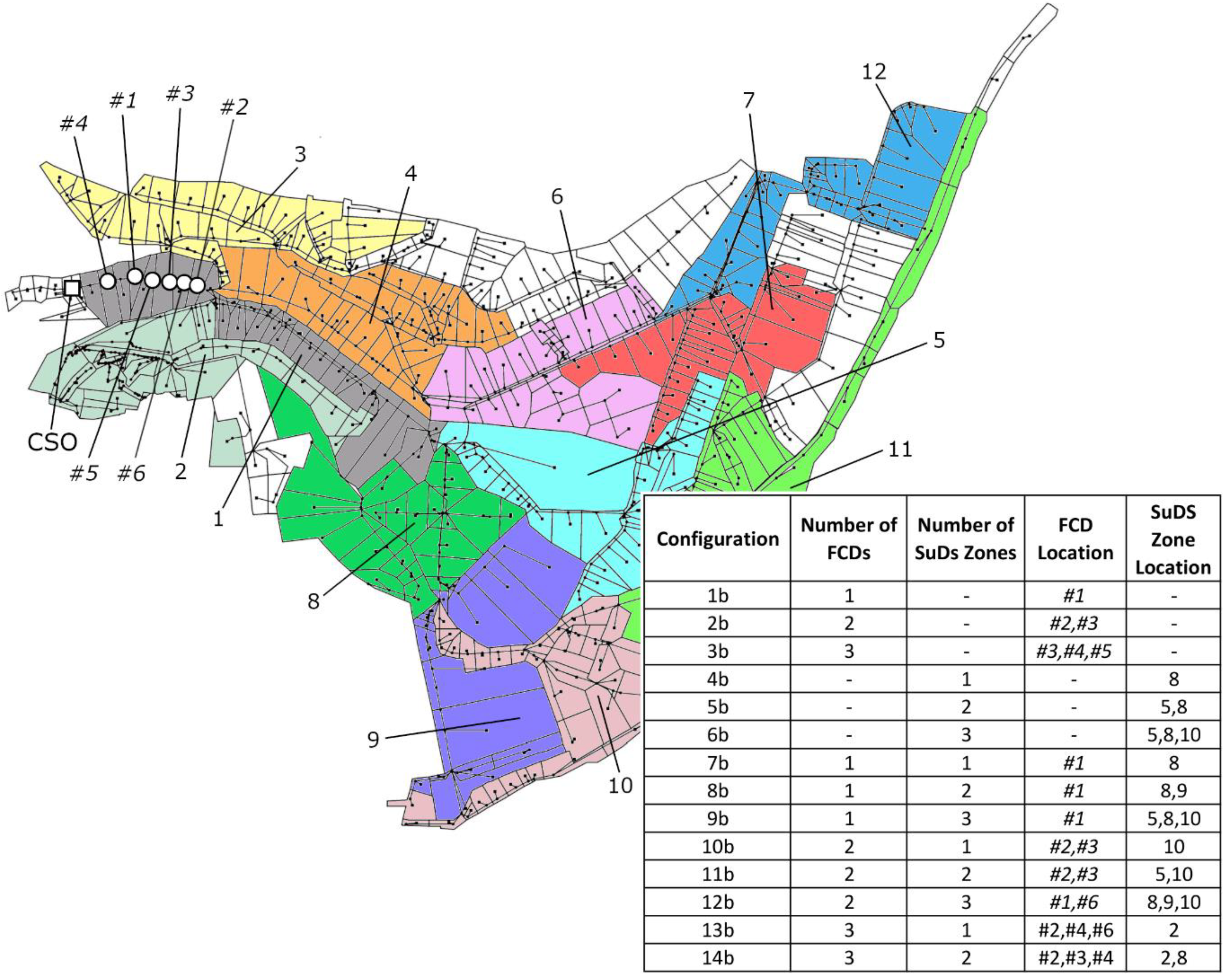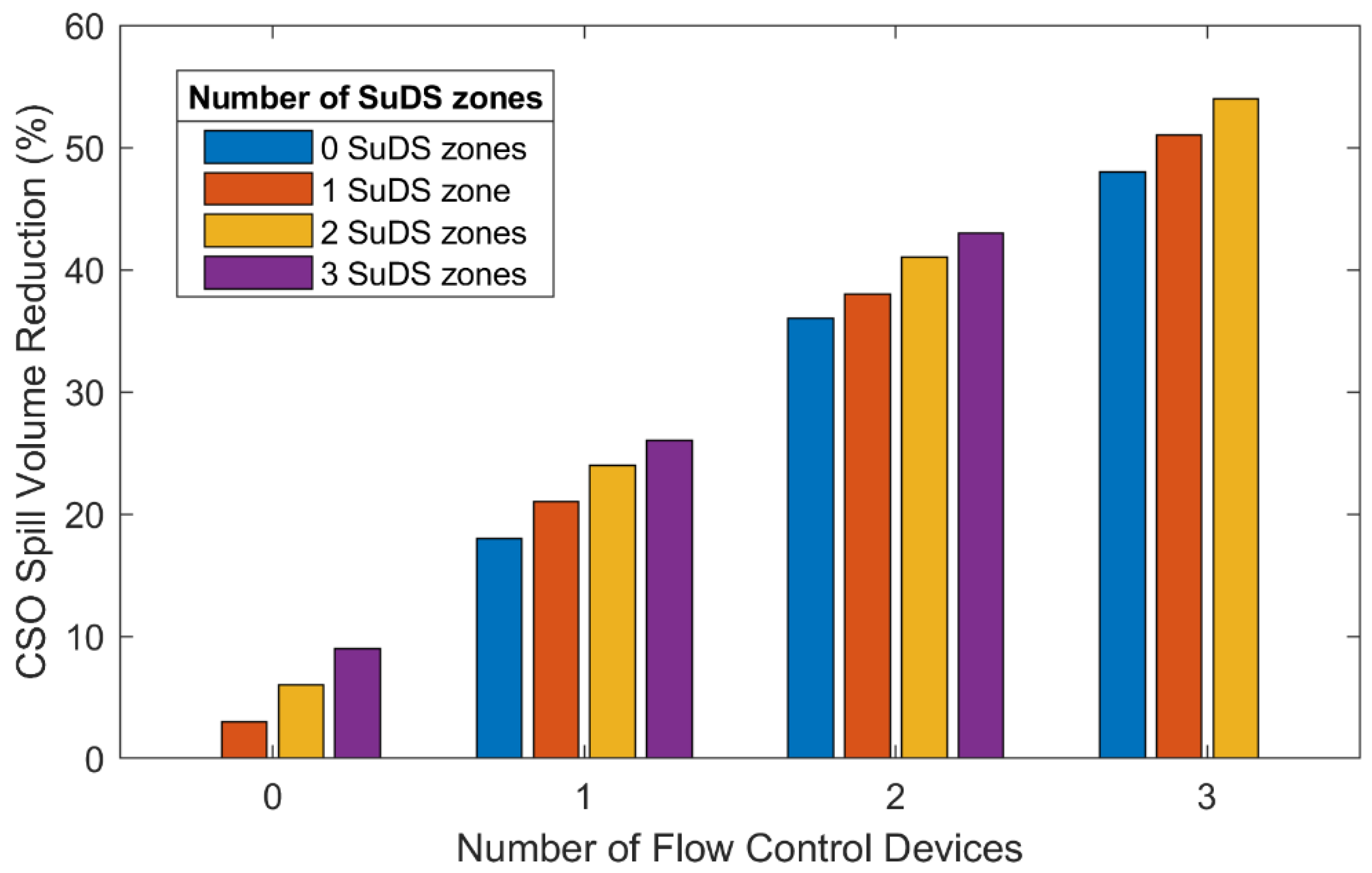1. Introduction
The enlargement of impervious areas and the increase in the frequency of extreme precipitation due to climate change pose increasing challenges for the management and operation of urban drainage systems (UDS) [
1,
2,
3]. Without adapting UDS, the frequency and magnitude of combined sewer overflows (CSOs) are expected to increase. Overflow discharges are recognized as a source of pollution for receiving water bodies, and CSO spill reduction is promoted and supervised by regulatory bodies [
4,
5]. Conventional urban drainage solutions consider the enlargement of the drainage infrastructure or the expansion of the storage capacity with construction-based solutions. Both feature high up-front investment costs and are coming under increased scrutiny due to potentially high embedded carbon and/or carbon emissions associated with pumping [
6,
7]. Therefore, there is increasing interest in the water sector in developing decentralized and distributed technologies to manage sources of pollution and runoff volumes [
8] as well as to increase the flexibility of existing drainage infrastructure in response to future climate trends [
9].
SuDS (sustainable drainage systems), also known as LIDs (low-impact developments) or BMPs (best management practices), are distributed source controls that are implemented to manage runoff volumes within urban catchments [
10]. These systems aim to enhance natural processes such as infiltration, percolation, evaporation, and attenuation with green infrastructures, reducing or removing stormwater volumes entering the existing sewage system. SuDS may include green roofs, bioretention cells, permeable pavement, vegetated swales, and infiltration trenches, among others, and are known to provide water quality, biodiversity, and amenity benefits [
11]. However, the widespread implementation and management of distributed LID-BMPs-SuDS practices may be challenging due to space availability, especially in highly urbanized areas [
12], and spatially varied socioeconomic constraints (e.g., lack of public interest and support, and private and public lands owned by different parties) [
13,
14].
Another alternative to increase the capacity of UDS are real-time control (RTC) systems. RTC is designed to achieve the real-time management of existing UDS through the continuous monitoring of process data (e.g., water levels and flow) and the dynamic adjustment of flow conditions with flow control devices (FCDs, e.g., pumps, sluice gates, and moveable weirs) [
15,
16]. RTC systems can be classified as local control systems or system-wide control systems based on their complexity and control scope [
15,
17]. RTC systems can potentially be a cost-effective solution, depending on the type and size of the system. The practical applications of RTC systems have mostly been documented for large case studies, with many operators still reluctant to adopt RTC systems [
18]. In engineering practice, the opinion often prevails that RTC requires more effort than conventionally operated systems [
19].
CENTAUR is a local RTC system that was designed to mitigate CSO spills and/or urban flooding in sewer networks, increasing the performance of existing drainage infrastructure [
20,
21]. CENTAUR consists of FCDs, inserted into existing manholes, that mobilize the existing in-pipe storage capacity to regulate the water level at predefined target locations (e.g., the CSO chamber and manholes prone to urban flooding). An FCD is composed of a movable sluice gate coupled with an emergency overflow weir above the sluice gate, which allows the flow to bypass the sluice gate in the case of extreme events. The gradual opening and closing of the sluice gate are controlled by an autonomous fuzzy logic algorithm based on real-time in-sewer-level information, which is more flexible than traditional PID (proportional integral derivative) controllers when input parameters are highly variable. The emergency overflow weir prevents sewer overflow upstream of the FCD installation site. FCDs can easily be relocated to different locations (i.e., manholes) with limited civil works to address changes in land use and future climate trends. Therefore, CENTAUR offers a flexible solution to increase the resilience of UDS when managing stormwater volumes during rainfall events, with low costs when compared to traditional alternatives (e.g., storage tanks).
The performance of both SuDS and RTC structures for CSO spill mitigation can be maximized by optimizing their spatial distribution, type, and size. However, due to the high number of possible implementation schemes, especially in large catchments, as well as the large number of constraints (e.g., physical and socioeconomic) that are potentially involved in the selection, traditional trial-and-error approaches often deliver suboptimal designs, and optimization-based methodologies are preferred [
12]. Numerous studies have considered the spatial optimization of either SuDS or distributed RTC systems, which is commonly achieved by coupling SWMM or SUSTAIN models with evolutionary algorithms in a simulation–optimization framework [
22,
23,
24,
25]. An extensive bibliometric review of design optimization (allocation, type, and dimensioning) and the performance evaluation of multiple SuDS in UDS can be found in [
26]. Similarly, the efficient placement of flow control devices is a crucial step in the design of cost-effective RTC systems in UDS [
27,
28]. Recently, [
29] developed a simulation–optimization framework to identify optimal FCD placement schemes for overflow spill mitigation at a single CSO, combining a genetic algorithm with an SWMM model. In [
30], the authors further developed the method, extending its applicability to larger UDS featuring multiple CSO locations. However, limited research has been found on aiming to understand how RTC and SuDS systems interact hydraulically and/or achieve added benefits through combining these systems. Experimental and modeling studies reviewed by [
31] demonstrated how the potential benefits achieved by nature-based solutions (i.e., detention basins, bioretention cells, and green roofs) can be enhanced by coupling such systems with RTC. For example, in [
32] the performance of stormwater detention basins was improved through the dynamic control of regulators (i.e., outlet valves) using rainfall forecasts, while [
33] conducted an experimental study on the application of RTC systems to stormwater biofilters for rainfall harvesting and reuse. In [
8], the authors found that the RTC performance in reducing CSO spill volumes, consisting of FCDs installed at different locations within the sewer network, could be further enhanced by coupling the system with SuDS implemented at the catchment level.
The above studies either refer to more traditional in-sewer RTC systems such as PID controllers and model predictive control or the RTC of the SuDS itself. Hence, there is currently a lack of understanding concerning the hydraulic interactions between local autonomous FL-controlled RTC and SuDS systems within UDS and how they affect optimal location selection for these systems at the urban catchment scale. As far as the authors are aware, to date, no robust and efficient methodology to design implementation strategies for local autonomous FL-controlled RTC combined with SuDS systems to achieve a given level of performance can be found in the literature. Furthermore, most existing spatial optimization studies focus on single case-study catchments, with little consideration of how the type and nature of the catchment influence the effectiveness of the solution. Current challenges include the time-consuming nature of optimization in large UDS and the need to accurately simulate the hydraulics within the UDS to fully capture the interactions between different systems (e.g., green infrastructure plus FCDs).
This research aimed to investigate the hydraulic interaction and potential enhancement when implementing both CENTAUR local RTC and SuDS for CSO spill volume reduction in two case-study catchments with varying characteristics and to develop a methodology for the placement of such schemes to achieve a given level of performance. The specific objectives were to (1) adapt a genetic algorithm methodology for the optimization of the placement of RTC actuators as well as simplified SuDS systems in a UDS; (2) simulate the performance of different optimized combinations of SuDS and RTC solutions for CSO spill mitigation in two study catchments against benchmark networks with no intervention; and (3) validate the performance of RTC coupled with SuDS using a continuous rainfall time series and consider the relative performance in the different catchments.
4. Discussion
In this study, the spatial allocation of locally controlled FCDs and simplified SuDS systems was optimized using a GA-based methodology to reduce CSO spill volumes in two case-study catchments. Three scenarios were evaluated: CSO spill reduction solely based on RTC, CSO spill reduction solely based on SuDS, and CSO spill reduction achieved by RTC combined with SuDS.
When reducing overflow spills with the local RTC, large differences in the spatial allocation of FCDs were obtained by GA, depending on the case-study catchment that was evaluated. This was mainly due to the different topographies, pipe geometries, and resulting distributions of storage capacity within the two case studies. In the flatter Arendonk catchment, the effect of a single partially or fully closed gate on flows and levels propagated far upstream along the pipe branches. The usage of the existing storage capacity was thus maximized by the GA by favoring FCDs positioned in different segments of the drainage system. In the Arendonk catchment, the GA did not always favor FCD locations close to the CSO regulated by the RTC system, which could increase the overflow spill volumes discharged at the other CSOs located in the central/upper portion of the catchment. The maximum capacity was reached in several segments of the sewer network immediately upstream of the CSO, preventing the FCDs from successfully mobilizing additional in-sewer storage capacity to store stormwater during rainfall events. In contrast, the Zona Central catchment featured a single combined sewer overflow, steep pipe gradients in the central/upper portion of the catchment, and flatter pipe gradients in the downstream area where the CSO was located. This uneven distribution of in-sewer storage capacity led FCDs to always be positioned along the pipe branch immediately upstream of the CSO, where the pipe diameters were significantly larger compared to other portions of the UDS. Due to the proximity between the FCDs, the joint storage volume capacity was partially mobilized by the gates along the same pipe branch when storing run-off volumes during rainfall events.
SuDS zones were generally located in the central/upper portion of the Zona Central catchment, while the central/lower catchment areas were preferred when allocating SuDS in the Arendonk model. This was mostly due to the different hydrological responses of the catchments to rainfall inputs. Zona Central had steeper slopes and a faster response time, with runoff attenuation in the upper part of the catchment resulting in efficient reductions in the overflow volumes discharged at the single downstream CSO at the time of the peak. Arendonk featured a flatter network with multiple CSOs in the central/upstream part of the catchment, with the highest reduction in overflow volumes achieved by SUDs located closer to the regulated CSO.
In this study, SuDS were implemented into clusters of subcatchments (i.e., SuDS zones), limiting the number of potential SuDS placement schemes tested by the GA through hydraulic analysis. The impact of the SuDS in reducing CSO spills was influenced by the subdivision of the watershed into clusters of subcatchments, with different zonations potentially leading to higher CSO spill volume reductions achieved by smaller SuDS zones. The choice of SuDS zone size is also expected to have a significant impact on the computational load required by the optimization–simulation framework. Smaller SuDS zones can provide more tailored solutions to efficiently manage runoff volumes at the catchment level, limiting the conversion of impervious area to pervious area needed to achieve a given level of performance. However, smaller SuDS zones result in a higher number of possible combinations between the number and position of SuDS zones within the catchment, and therefore more computational time is needed by the GA to identify near-optimal solutions. Larger clusters of subcatchments instead lead to lower computational loads at the expense of less refined SuDS placement schemes. In this study, the size of the SuDS zones was found through initial trials to provide an efficient balance between the number of potential placement schemes tested by the GA, the rate of convergence, and the computational time. The impact of the choice of SuDS zone size and location in reducing CSO spill volumes remains for future research, as this study mainly focused on developing a simulation–optimization framework to identify the optimal placement of RTC actuators combined with simplified SuDS systems within UDS.
SuDS were simulated as impervious areas converted to pervious areas, a highly simplified representation of green infrastructure that enhances the capability of the proposed GA-based method to identify optimal SuDS placement schemes in a reasonable timeframe. Nonetheless, the methodology can be extended to consider specific types of SuDS (e.g., infiltration trenches, green roofs, and detention basins). Following the experience from this paper, it is hypothesized that it may be quicker to optimize their location selection by simulating the effect of simplified SuDS as a small number of changes to the runoff hydrograph from the subcatchments (e.g., peak delay and/or reduction). After that, SuDS could be designed suiting the location selected by the optimization-based framework while providing a desired runoff hydrograph. This process is thought to be more efficient than simultaneously optimizing individual SuDS locations and design parameters, such as type selection, infiltration capacity, SuDS dimensions, and medium, especially when combining SuDS with FCDs controlled by RTC systems. The implementation of green infrastructure in highly urbanized areas is highly influenced by space availability and the opportunity for retrofitting (e.g., land and home/commercial area ownership). When optimizing specific types of SuDS, a more detailed spatial analysis of the landscape and topographic conditions of the catchment through geographic information systems (GIS) can be used to exclude unfeasible SuDS placement schemes due to practical or socioeconomic limitations (e.g., land use and land ownership), reducing the search space of all feasible solutions evaluated by the GA solver. As the solution time may rise exponentially, a sensitivity analysis is recommended to better investigate the trade-off between computational time and the number of SuDS decision variables included in the optimization-based method. This analysis remains for further research, as this study mainly focused on higher-level planning and the design case of infiltration-based structures.
In both case studies, the implementation of locally controlled FCDs always corresponded to higher CSO spill volume reductions compared to the implementation of simplified infiltration-based SuDS. Large portions of unused in-sewer storage capacity were mobilized by the flow controllers to regulate the water level at the CSO, with significant CSO spill volume reductions obtained in both the benchmark with RTC and benchmark with RTC + SuDS scenarios. The attenuation of runoff volumes obtained by SuDS resulted in limited CSO spill mitigation within the sewer networks, with SuDS performing slightly better during the less severe storm event in the Arendonk catchment (designed storm occurring seven times per year). FCD-SuDS configurations were also tested during continuous rainfall time series, resulting in reductions in the CSO spill volumes discharged from the baseline networks ranging between 23% and 45% when combining the local RTC with green infrastructure. In the Arendonk catchment model, during the 3-year rainfall series equivalent CSO spill volume reductions were achieved by different combinations of numbers and positions of FCDs and SuDS, providing alternatives to mitigate the impacts of CSO spills and fulfil environmental targets within the urban drainage system.
When coupling the local RTC with SuDS, higher performance was obtained when the spatial allocations of the two intervention measures were optimized simultaneously rather than individually, enhancing the combined benefits of FCDs and SuDS in managing runoff volumes. For example, in the Arendonk catchment, a CSO spill volume reduction equal to 71% achieved by two FCDs could be further increased by 8% by combining the RTC with one SuDS zone or by 21% by combining the RTC with two SuDS zones, preventing the sewer overflow spill in the baseline network. Moreover, comparable CSO spill volume reductions could be achieved by different FCD-SuDS configurations, widening the choice of potential intervention schemes with similar levels of performance.
In this study, the FCD and SuDS locations mostly changed depending on the number of intervention measures that were implemented, resulting in largely different unique optimal placement schemes. While installation site accessibility and road/traffic management might delay or restrict the deployment of FCDs at specific control sites (i.e., manholes), an advantage of FCDs controlled by local RTC is that implemented FCDs can generally be repositioned to different locations, so additional FCDs can be installed in the UDS while maintaining the optimal spatial layout. The GA-based optimization can also be rerun to cope with new urban development and rainfall trends, adjusting the locations of previously placed FCDs if needed. The locations of SuDS at the catchment level were instead largely influenced by the opportunity for retrofitting and other factors such as land use and home/commercial area ownership that may impede the implementation of optimal SuDS or RTC+SuDS configurations in stages. It would not be possible to relocate SuDS once implemented; it would only be possible to add more SuDS. However, compared to FCDs, SuDS can have various advantages, such as amenity [
10], increasing biodiversity [
50,
51], water quality improvement [
24,
52], and the restoration of infiltration, interception, and detention/retention regimes [
12].
